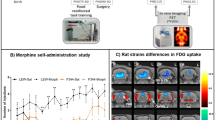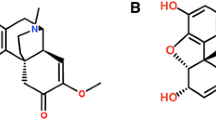Abstract
Rats with posterior medial forebrain bundle (PMFB) lesions and control rats were administered morphine chronically for 4 or 5 days via implanted subcutaneous silicone reservoirs. Following cessation of morphine administration after five days, PMFB rats showed less withdrawal-induced weight loss than control rats. Other PMFB and control rats were subjected to forced drinking of morphine solution for 9 days. PMFB rats consumed the morphine solution much more readliy than control rats, whereas intake of a quinine solution was similar in two other PMFB and control groups. These results suggest that the addictive and dependence properties of morphine may have separate mechanisms and based on previously reported neurochemical effects of PMFB lesions, that biogenic amines may be differentially involved in such mechanisms.
Similar content being viewed by others
References
Goode, P. G.: An implanted reservoir of morphine solution for rapid induction of physical dependence in rats. Brit. J. Pharmacol. 41, 558–566 (1971).
Heller, A.: Neuronal control of brain serotonin. Fed. Proc. 31, 81–90 (1972).
Ho, I. K., Lu, S. E. Stolman, S., Loh, H. H., Way, E. L.: Influence of p-chlorophenylalanine on morphine tolerance and physical dependence and regional brain serotonin turnover studies in morphine tolerant-dependent mice. J. Pharmacol. exp. Ther. 182, 155–165 (1972).
Joy, R. T., Emma, C. P., Mayer, J.: New rat feeding jar: use in study of relationships of food intake and body weight. J. appl. Physiol. 23, 289–290 (1967).
Shuster, L.: Tolerance and physical dependence. In Narcotic drugs. D. H. Clouet, ed., pp. 408–423. New York: Plenum Press 1971.
Ungerstedt, U.: Stereotaxic mapping of the monoamine pathways in the rat brain. Acta physiol. scand., Suppl. 367, 1–48 (1971).
Way, E. H. Loh, H., Shoh, F. H.: Morphine tolerance, physical dependence and synthesis of brain 5-hydroxytryptamine. Science 162, 1290–1292 (1968).
Wende, C. V., Sporelein, M. T.: Antagonism by DOPA of morphine analgesia. A hypothesis for morphine tolerance. Res. Comm. chem. Path. Pharm. 3, 37–45 (1972).
Author information
Authors and Affiliations
Additional information
This research was supported by NIMH grants MH 70082 and DA 00535 to S. D. Glick. The authors thank Stuart Greenstein for indispensable technical assistance.
Rights and permissions
About this article
Cite this article
Glick, S.D., Charap, A.D. Morphine dependence in rats with medial forebrain bundle lesions. Psychopharmacologia 30, 343–348 (1973). https://doi.org/10.1007/BF00429193
Received:
Issue Date:
DOI: https://doi.org/10.1007/BF00429193




